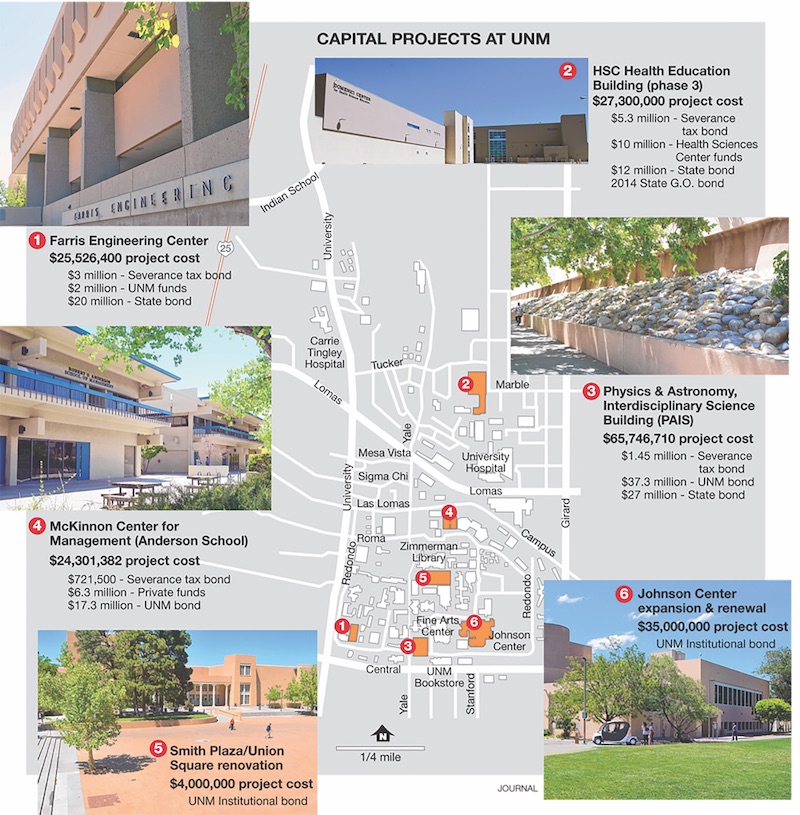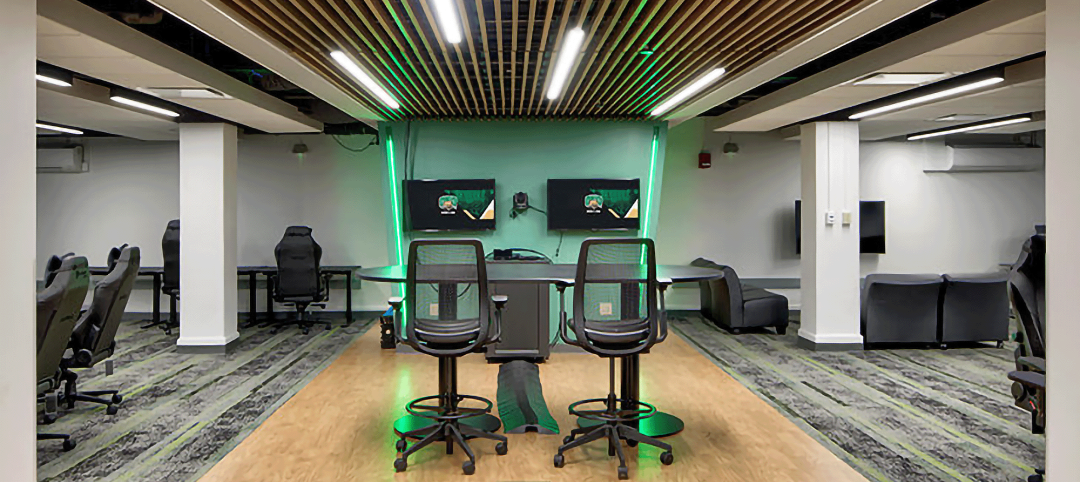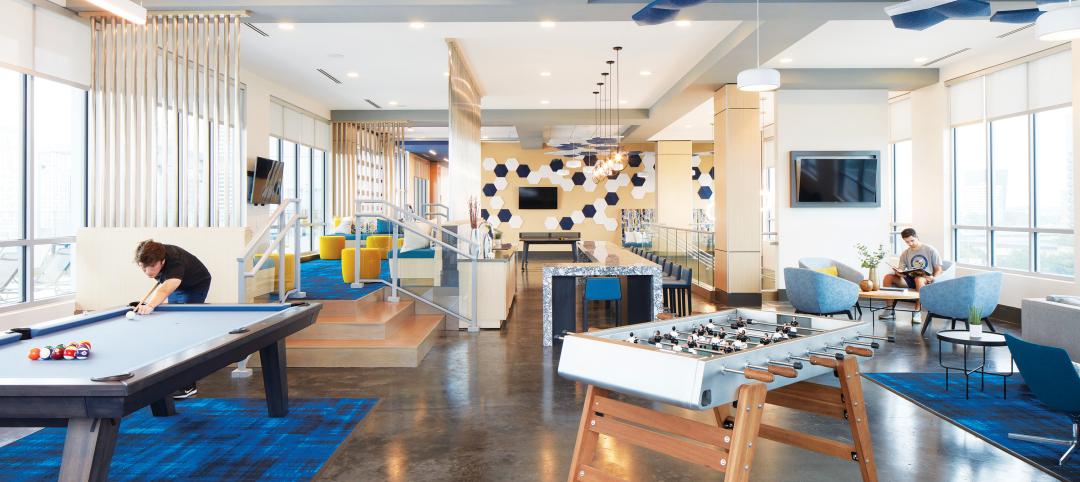Campus construction and renovation projects often come with hefty price tags. A few years ago, Duke University spent nearly $80 million on a new dining hall. Two recent projects that SmithGroupJJR designed include the $50 million Mike Ilitch School of Business at Wayne State University, now under construction in downtown Detroit, and the $82 million, 188,000-sf University of Wisconsin–LaCrosse Instructional Science Facility, a combination of allied health and STEM that will open next year.
As colleges sign off on ever-more-extravagant physical plant to help in their recruitment efforts, tuition hikes are putting college beyond the financial reach of the high school students they are trying to attract.
But colleges and universities are adept at tapping a variety of sources—taxpayers, investors, donors, and, yes, students—to fund their growth ambitions.
Bonds are one time-tested route. The University of New Mexico’s five-building construction program is being paid for primarily with bonds. Last year, North Carolina completed a $2 billion issue of Connect Bonds, $1.33 billion of which are earmarked for the 17 colleges in its UNC system.
Other colleges are asking their student bodies to approve annual user fees that would defray the cost of planned construction and renovation before the work gets started.
 The University of New Mexico’s five-building construction program is being financed by a combination of bonds, student fees, school funds, and private donations. Courtesy University of New Mexico.
The University of New Mexico’s five-building construction program is being financed by a combination of bonds, student fees, school funds, and private donations. Courtesy University of New Mexico.
State governments are also willing to finance college construction, albeit on a limited basis. Supplemental funding by the Massachusetts State Legislature helped pay for the $52 million, 87,500-sf Design Building at the University of Massachusetts Amherst, which had its official ribbon cutting in April. This is the first cross-laminated timber academic building in the U.S.
Greggrey Cohen, Simpson, Gumpertz & Heger’s National Practice Leader for structural repair and rehabilitation, who worked on the UMass Design Building, says that in recent years there has been a “big push” among colleges and universities in the Bay State to replace older buildings.
“The underlying strategy of our capital plan is to target investment in the areas of the highest impact, while balancing these investments across deferred maintenance, modernization, and new construction,” says Shane Conklin, UMass’s Associate Vice Chancellor for Facilities and Campus Services. Construction projects scheduled to open in the next two years include the relocation of a physical sciences building that will be integrated with a new 95,000-sf research building for chemistry and physics.
This isn’t to say that colleges and universities have unlimited access to capital. And their “reno-first” inclinations are a sign of their budgetary constraints.
“Everyone is still money conscious,” says Robert Quigley, of Architectural Resources Cambridge. His firm went through numerous meetings with Bentley University’s board before its Jennison Hall renovation budget got approved. “They are also conscious of the mistakes they made in the past being cheap,” he says. “They want to do a quality job.”
Related Stories
ProConnect Events | Jan 16, 2023
6 more BD+C ProConnect Events in 2023 – The videos show why you should participate
ProConnects bring building product manufacturers and suppliers together with architects, contractors, builders, and developers to discuss upcoming projects and learn about new products and technical solutions.
Adaptive Reuse | Jan 12, 2023
Invest in existing buildings for your university
According to Nick Sillies of GBBN, students are increasingly asking: "How sustainable is your institution?" Reusing existing buildings may help answer that.
University Buildings | Dec 22, 2022
Loyola Marymount University completes a new home for its acclaimed School of Film and Television
California’s Loyola Marymount University (LMU) has completed two new buildings for arts and media education at its Westchester campus. Designed by Skidmore, Owings & Merrill (SOM), the Howard B. Fitzpatrick Pavilion is the new home of the undergraduate School of Film and Television, which is consistently ranked among the nation’s top 10 film schools. Also designed by SOM, the open-air Drollinger Family Stage is an outdoor lecture and performance space.
Adaptive Reuse | Dec 21, 2022
University of Pittsburgh reinvents century-old Model-T building as a life sciences research facility
After opening earlier this year, The Assembly recently achieved LEED Gold certification, aligning with the school’s and community’s larger sustainability efforts.
Esports Arenas | Dec 19, 2022
Ohio University’s OHIO Esports Arena redefines video gaming
If a college student enjoys film studies, there is probably a place on campus where they can join other film buffs. But where can students who like video games go?
Sponsored | Resiliency | Dec 14, 2022
Flood protection: What building owners need to know to protect their properties
This course from Walter P Moore examines numerous flood protection approaches and building owner needs before delving into the flood protection process. Determining the flood resilience of a property can provide a good understanding of risk associated costs.
Student Housing | Dec 7, 2022
9 exemplary student housing projects in 2022
Production continued apace this year and last, as colleges and universities, for-profit developers, and their AEC teams scrambled to get college residences open before the start of classes.
University Buildings | Dec 5, 2022
Florida Polytechnic University unveils its Applied Research Center, furthering its mission to provide STEM education
In Lakeland, Fla., located between Orlando and Tampa, Florida Polytechnic University unveiled its new Applied Research Center (ARC). Designed by HOK and built by Skanska, the 90,000-sf academic building houses research and teaching laboratories, student design spaces, conference rooms, and faculty offices—furthering the school’s science, technology, engineering, and mathematics (STEM) mission.
Education Facilities | Nov 30, 2022
10 ways to achieve therapeutic learning environments
Today’s school should be much more than a place to learn—it should be a nurturing setting that celebrates achievements and responds to the challenges of many different users.
Data Centers | Nov 28, 2022
Data centers are a hot market—don't waste the heat!
SmithGroup's Brian Rener shares a few ways to integrate data centers in mixed-use sites, utilizing waste heat to optimize the energy demands of the buildings.















